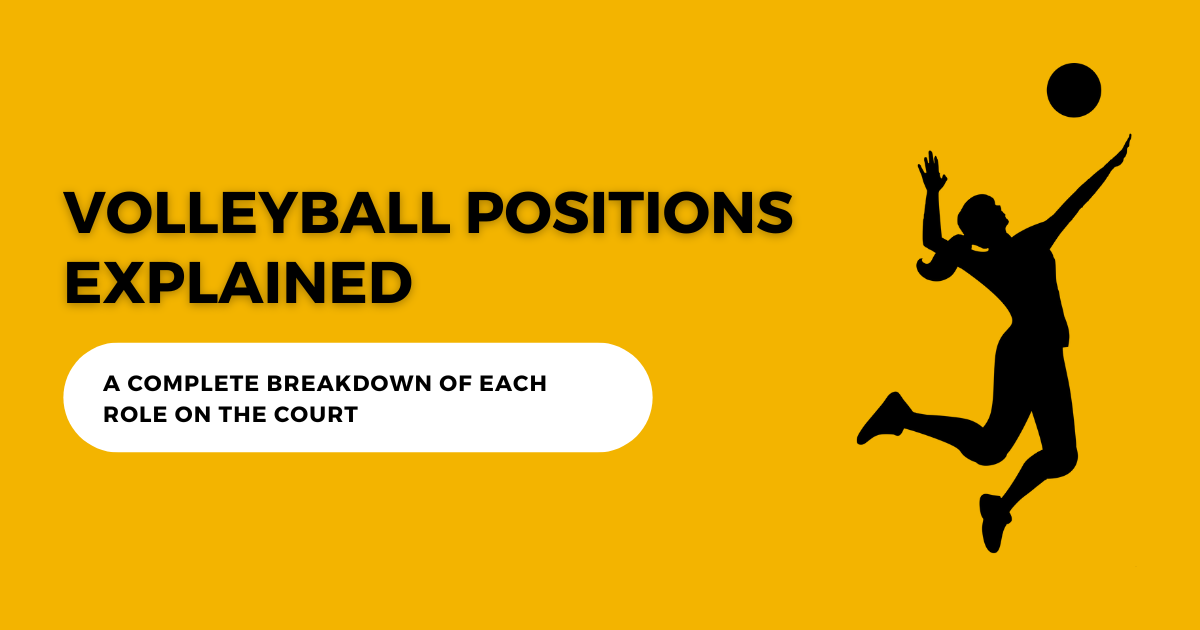Volleyball is a captivating sport that combines athleticism, strategy, and teamwork to create an exhilarating experience for both players and fans.
At the core of this fast-paced game are the specialized positions, each with a unique role and responsibility on the court. Here we will discuss all volleyball positions on court.
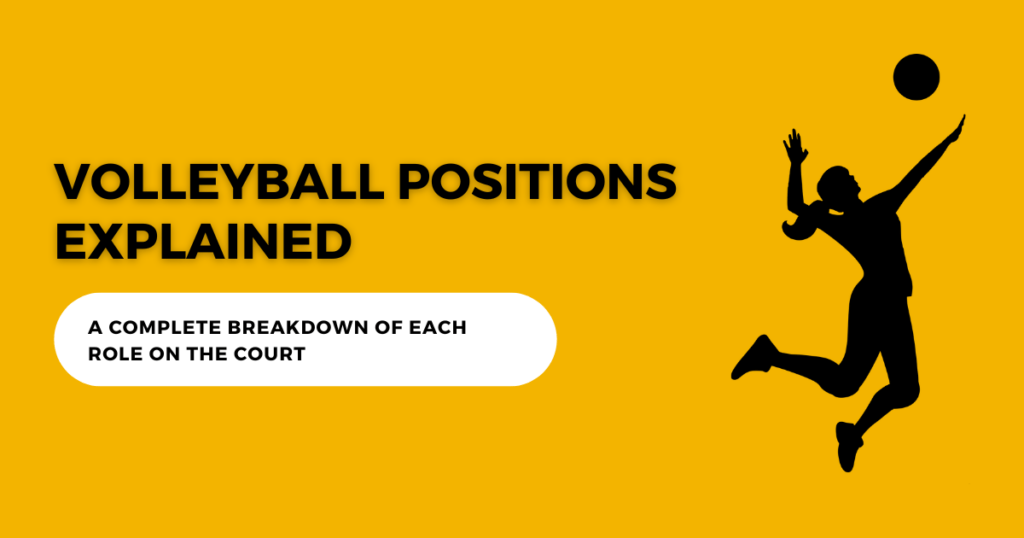
In this article, we will explore the critical roles of the setter, outside hitter, middle blocker, opposite hitter, libero, and defensive specialist, diving deep into their functions, required skills, and the impact of each position on the overall team performance.
The setter serves as the team’s playmaker, setting up the ball for attackers and directing the offense.
The outside hitter, positioned on the left side, is responsible for receiving serves and executing powerful attacks.
The middle blocker, located at the center of the court, focuses on blocking opponents’ attacks and performing quick offensive plays.
The opposite hitter, situated on the right side, takes on hitting and blocking responsibilities while also acting as a backup setter.
The libero, a specialized defensive player, excels in serve reception and digging but cannot attack or block.
Finally, the defensive specialist is a versatile back-row player, concentrating on serve reception, digging, and serving.
Together, these positions work in harmony to create a cohesive unit capable of executing stunning plays and outsmarting the opposition.
With a deeper understanding of each role, aspiring volleyball players can hone their skills, improve their teamwork, and elevate their game to new heights.
Volleyball Positions
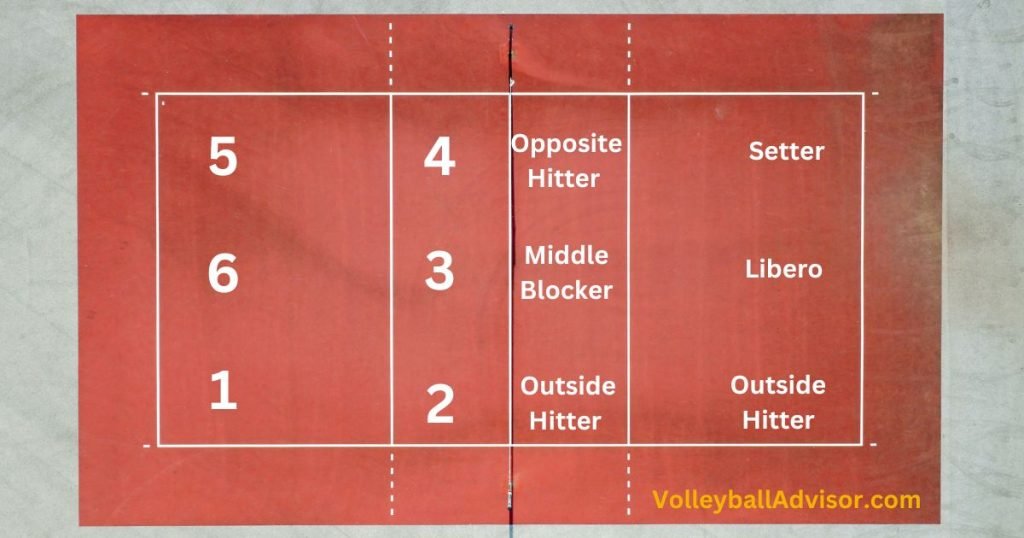
| Position Name | Short Info |
|---|---|
| Setter (S) | The playmaker is responsible for setting up the ball for attackers and orchestrating the offense. |
| Outside Hitter (OH) | Positioned on the left side of the court, responsible for receiving serves and executing attacks. |
| Middle Blocker (MB) | Situated in the center, primarily focused on blocking the opponent’s attacks and quick attacks. |
| Opposite Hitter (OPP) | Positioned on the right side, responsible for hitting and blocking, as well as serving as a backup setter. |
| Libero (L) | A specialized defensive player who excels in serve reception and digging, but cannot attack or block. |
| Defensive Specialist (DS) | A versatile defensive player who can replace any back-row player, focusing on serve reception, digging, and serving. |
About Volleyball
Volleyball is a popular team sport played by two teams of six players each, separated by a net on an 18m x 9m court.
The objective is to score points by sending the ball over the net and grounding it within the opponent’s court or forcing errors from the opposing team.
Combining athleticism, strategy, and teamwork, volleyball offers a thrilling experience for participants and spectators.
Played both indoors and outdoors, volleyball has various formats, including beach volleyball and indoor volleyball, making it a versatile and globally enjoyed sport.
Setter (S)
The Setter is a crucial position in volleyball, responsible for running the team’s offensive strategy and setting up their teammates for successful attacks.
They occupy the front row of the court and are the only player who can touch the ball with their hands above the height of the net.
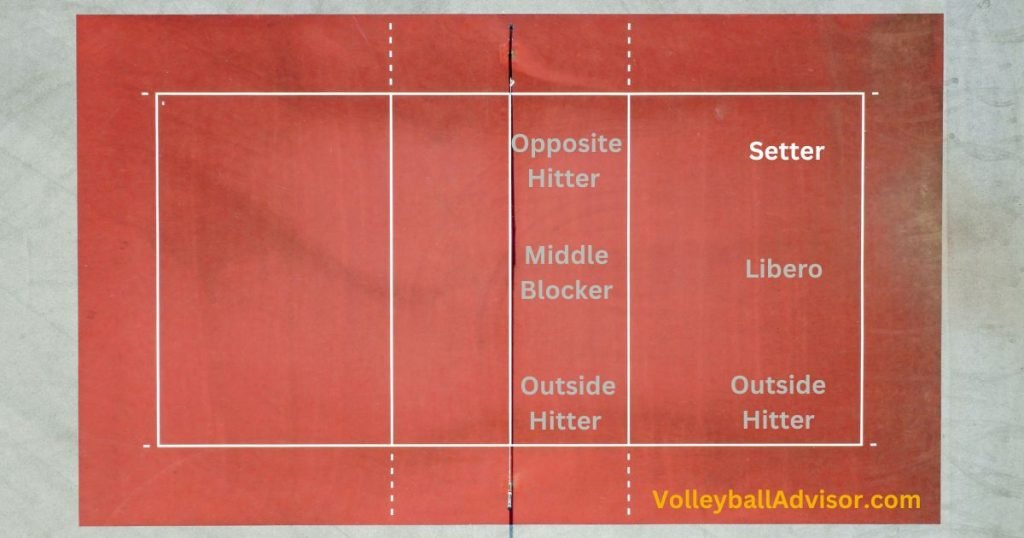
The Setter’s primary role is to receive the first pass from the opposing team and use their hands to set the ball to their teammates for an attack.
To do this, the Setter needs to have excellent hand-eye coordination, quick reflexes, and the ability to make quick and precise decisions.
The Setter also needs to have a thorough understanding of the game, including the different types of sets, defensive schemes, and the strengths and weaknesses of both their team and opponents.
They need to be able to read the opposition’s defense to find weaknesses to exploit and adjust the team’s offensive strategy accordingly.
Roles and Responsibilities
In the dynamic world of volleyball, each player’s role is crucial to the team’s success.
Here, we will delve into the specific roles and responsibilities of a volleyball setter.
Whether you’re a seasoned player seeking deeper insights or a newcomer exploring potential positions, understanding the setter’s contributions is paramount.
Running the Team’s Offense:
The primary and most apparent role of a setter in volleyball is to orchestrate the team’s offense.
This involves the strategic placement of the ball for hitters to capitalize on scoring opportunities. Key aspects of this role include:
Consistency and Precision
Setters touch the ball more frequently than any other player, ensuring that they have the responsibility of maintaining consistency and precision in their sets.
Regardless of the pass quality, a skilled setter places the ball in the same general area consistently.
Understanding Hitters
A successful setter comprehends the individual preferences and needs of their hitters. Different players thrive on varied types of sets, such as higher sets for tall players or faster sets for those who prefer quick attacks. Tailoring sets to accommodate each hitter maximizes offensive efficiency.
Recognizing Attack Options
Setters must be aware of all potential attack options on their side of the net. Identifying the strengths of each hitter and understanding the opposing team’s blockers allows setters to make informed decisions, optimizing the team’s chances of scoring.
Grasping the Game Plan
As the leader of the team’s offense, setters need a thorough understanding of the overall game plan. This involves comprehending defensive strategies, recognizing team strengths, and strategically positioning players to execute the desired plays.
Being a Strong Leader and Presence on the Court
Beyond running the offense, a setter holds a distinct leadership role on the court. This involves effective communication, both with the coach and teammates, contributing to a cohesive and focused team environment.
Communication Skills
Setters are pivotal in on-court communication. Their ability to convey instructions, call plays, and maintain a steady dialogue with teammates enhances the team’s coordination and performance.
Leadership Qualities
Leadership extends beyond communication. Setters must exhibit qualities such as focus, decisiveness, and a calming presence on the court.
Being a reliable leader contributes to team cohesion during critical moments.
Being an All-Around Player:
While setters may not be the point scorers, they play a multifaceted role that extends beyond setting. Embracing additional responsibilities makes them valuable assets to the team.
Defensive Proficiency
Setters often excel in defensive skills, contributing to keeping the ball off the ground. Despite potentially being smaller players, their defensive prowess adds an extra layer to the team’s overall performance.
Serving Excellence
A setter’s contribution extends to serving and creating strategic challenges for the opposing team.
A well-placed and powerful serve can disrupt the opponent’s rhythm and contribute to the team’s defensive efforts.
In conclusion, the setter in volleyball is a versatile player with multifaceted roles and responsibilities.
Running the team’s offense, being a strong leader, and contributing defensively and through serving, the setter is akin to the quarterback on the volleyball court.
Aspiring setters should hone these skills to become invaluable assets to their teams.
Outside Hitter (OH)
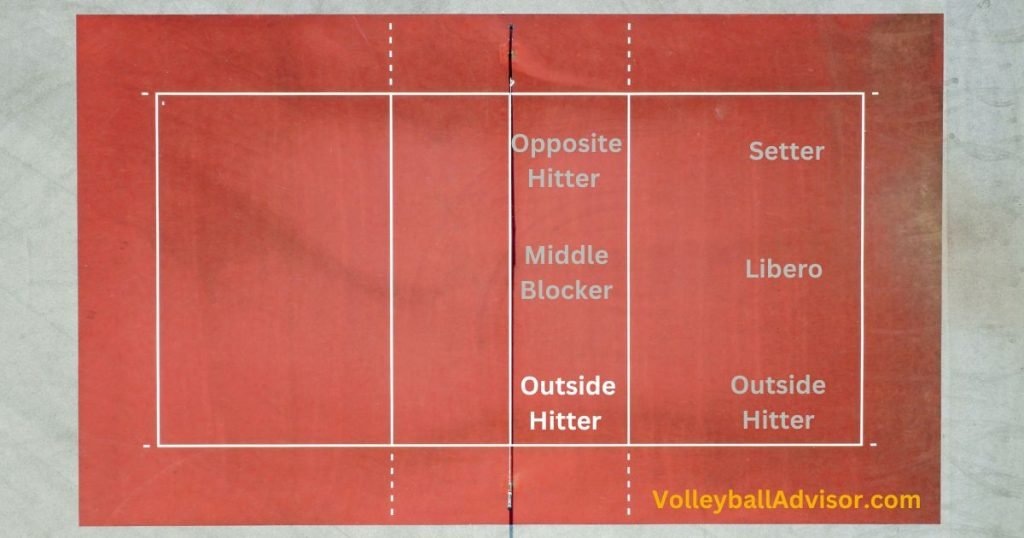
The Outside Hitter (OH) is one of the most important positions in volleyball, responsible for scoring points and contributing to the team’s overall success.
The OH plays on the left side of the court and is usually the team’s primary attacker.
Role and responsibilities:
The OH’s primary role is to attack the ball, score points, and create opportunities for their team. Their responsibilities include:
- Receiving the ball in serve receive
- Attacking the ball from the left side of the court
- Blocking and defending against the opposing team’s attacks
- Serving the ball
- Supporting their teammates on the court
- Being a reliable option for their Setter to set the ball to
Essential skills and attributes:
To excel as an OH, a player needs to possess certain skills and attributes, including:
- Strong attacking skills, including hitting, tipping, and roll shots
- Good blocking and defending skills
- Excellent jumping ability and agility
- Solid serving skills
- Good communication skills to work effectively with the Setter and other teammates
- Mental toughness and the ability to stay focused and perform well under pressure
- Versatility to adjust to different game situations and strategies
In conclusion, the Outside Hitter position is crucial to a team’s success in volleyball, requiring a combination of strong attacking and defensive skills, communication, mental toughness, and adaptability.
- Image: An outside hitter in action or a famous outside hitter
Middle Blocker (MB)
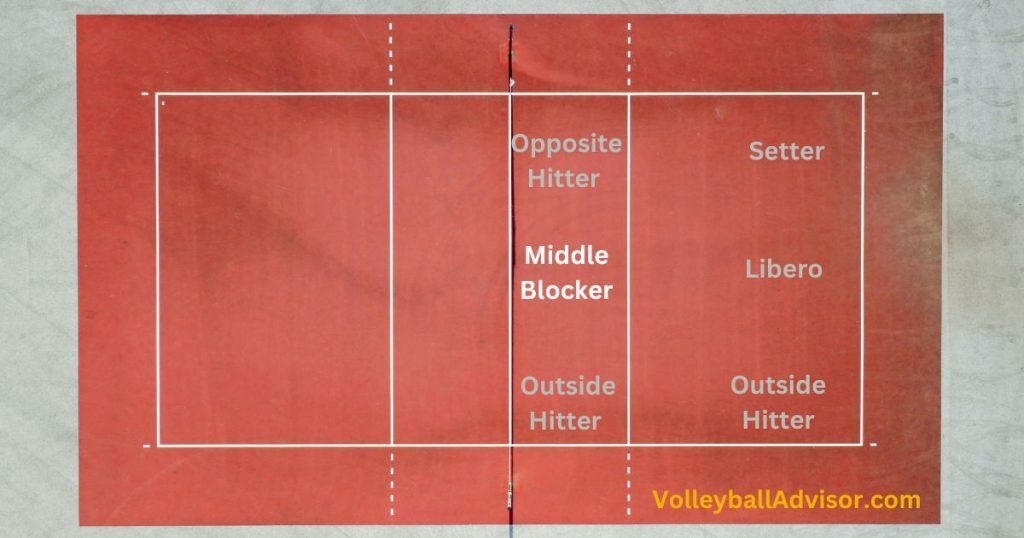
Middle Blocker (MB) is a crucial position in the game of volleyball, characterized by its pivotal role in both offensive and defensive strategies.
Often regarded as the backbone of the team, Middle Blockers hold a unique responsibility to contribute to their team’s performance through effective blocking, quick attacking, and strategic decision-making.
As the game of volleyball has evolved over the years, so too has the importance of the Middle Blocker position.
Today, this role is vital in helping teams achieve success on the court by setting up a formidable defense and creating offensive opportunities.
Role and Responsibilities
- Effective blocking: Shut down opponents’ attacks by reading the setter’s intentions and reacting swiftly to block the ball.
- Quick attacking: Exploit gaps in the opposing defense with fast and precise attacks to score points for the team.
- Strategic decision-making: Anticipate opponents’ moves and adjust positioning to optimize defensive coverage and offensive opportunities.
- Serve to receive: Help the team maintain a strong serve reception, thereby enabling the setter to run an efficient offense.
- Communication: Coordinate with teammates to establish a robust defensive system and ensure a smooth transition between defense and offense.
Essential Skills and Attributes
- Exceptional vertical jump: To excel in blocking and attacking above the net.
- Speed and agility: To move quickly across the court and react to opponents’ plays.
- Strong mental focus: To read the game and make split-second decisions under pressure.
- Effective communication: To work seamlessly with teammates and establish a strong team dynamic.
- Technical proficiency: To master the fundamentals of blocking and attacking techniques.
Opposite Hitter (OPP)
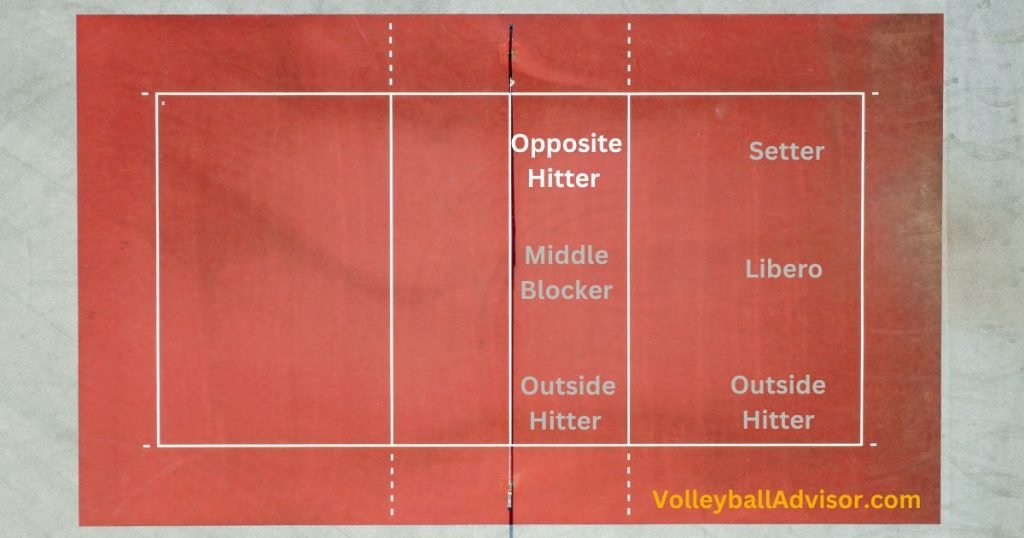
The Opposite Hitter (OPP), also known as the Right Side Hitter, is a vital position in volleyball that holds a significant responsibility in both offensive and defensive plays.
Often considered the team’s powerhouse, Opposite Hitters are usually tasked with delivering powerful and effective attacks, exploiting the weaknesses of the opposing team’s defense.
Additionally, these players are responsible for blocking the opponent’s outside hitters, requiring them to possess strong defensive skills.
A proficient Opposite Hitter can make a substantial difference in a team’s performance, influencing the outcome of the game through their powerful attacks, tactical approach, and dependable defense.
Role and Responsibilities
- Offensive attacking: Deliver powerful and precise attacks from the right side of the court, aiming to score points and pressure the opposing team’s defense.
- Blocking: Block the opponent’s outside hitters, shutting down their attacks and disrupting their offensive strategies.
- Serve reception: Assist in receiving the opponent’s serves, ensuring a smooth transition to offense.
- Back-row defense: Contribute to the team’s overall defensive efforts by covering the back-row area and digging the opponent’s attacks.
- Communication: Work closely with teammates to establish a cohesive team dynamic and execute strategic plays effectively.
Essential Skills and Attributes
- Powerful hitting: Possess a strong arm swing and effective hitting technique to deliver powerful attacks from the right side.
- Vertical jump: Demonstrate exceptional jumping ability to block effectively and attack above the net.
- Agility and speed: Display quickness and agility to cover the court, ensuring a strong defensive presence and swift offensive moves.
- Anticipation and decision-making: Read the game effectively and make quick decisions under pressure to exploit the opposing team’s weaknesses.
- Communication: Collaborate with teammates to maintain a strong team dynamic and execute strategic plays.
Libero (L)
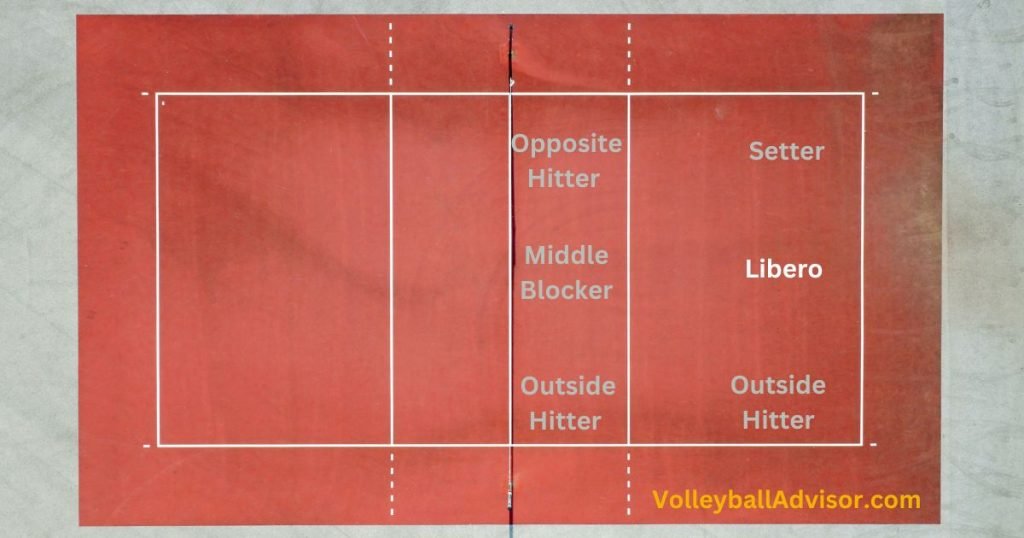
The Libero (L) is a specialized defensive position in volleyball, introduced to the sport in the late 1990s to enhance the overall level of play and introduce a new strategic element to the game.
The Libero is responsible for maintaining a solid defense, particularly in the backcourt, and is distinguished by their different colored jersey, setting them apart from their teammates.
This crucial role requires exceptional ball-handling skills, quick reflexes, and an unwavering commitment to defense.
The introduction of the Libero position has dramatically improved the defensive capabilities of teams and elevated the sport’s excitement and competitiveness.
Role and Responsibilities
- Serve reception: Consistently receive the opponent’s serves, providing the setter with accurate passes to initiate offensive plays.
- Digging: Demonstrate quick reflexes and precise positioning to dig opponents’ attacks, preventing them from scoring and keeping the ball in play.
- Covering the court: Utilize speed and agility to cover large areas of the backcourt, ensuring a solid defense.
- Communication: Coordinate with teammates to establish an effective defensive system, sharing information about opponents’ tendencies and strategies.
- Free-ball passing: Deliver accurate and consistent free-ball passes to the setter, maintaining offensive opportunities for the team.
Essential Skills and Attributes
- Ball control: Possess outstanding ball-handling skills, ensuring accurate and consistent passes under pressure.
- Quick reflexes: Demonstrate exceptional reflexes and anticipation to react swiftly to opponents’ attacks.
- Agility and speed: Exhibit excellent agility and speed to move efficiently around the court, covering a wide range of defensive responsibilities.
- Spatial awareness: Display a strong understanding of court positioning and awareness of teammates’ movements to optimize defensive coverage.
- Communication: Exhibit effective communication skills to work seamlessly with teammates, share information, and establish a robust defensive system.
- Mental toughness: Show resilience and determination to stay focused and maintain a high level of performance under pressure.
As the Libero position continues to evolve, its significance in modern volleyball becomes increasingly apparent.
The Libero’s unique skills and defensive expertise are essential components in a team’s overall strategy, and their impact on the game cannot be overstated.
Defensive Specialist (DS)
The Defensive Specialist (DS) is a critical position in volleyball, often regarded as the unsung hero of the team.
While not as prominent as other positions, such as the setter or hitter, the Defensive Specialist’s primary focus is on providing consistent and reliable defense, particularly in the backcourt.
Although similar to the Libero in terms of defensive responsibilities, the Defensive Specialist does not wear a different colored jersey and has fewer restrictions in terms of rotations and substitutions.
Their ability to seamlessly transition between offensive and defensive plays makes them a valuable asset to any team. The Defensive Specialist’s unwavering commitment to defense and their ability to read the game is crucial for a team’s success on the court.
Role and Responsibilities
- Serve reception: Accurately receive the opponent’s serves, providing the setter with precise passes to initiate offensive plays.
- Digging: Display quick reflexes and appropriate positioning to dig opponents’ attacks, preventing them from scoring and keeping the ball in play.
- Back-row defense: Contribute to the team’s overall defensive efforts by covering the back-row area and digging the opponent’s attacks.
- Covering the court: Utilize speed and agility to cover large areas of the backcourt, ensuring a solid defense.
- Communication: Coordinate with teammates to establish an effective defensive system, sharing information about opponents’ tendencies and strategies.
Essential Skills and Attributes
- Ball control: Possess excellent ball-handling skills, ensuring accurate and consistent passes under pressure.
- Quick reflexes: Demonstrate exceptional reflexes and anticipation to react rapidly to opponents’ attacks.
- Agility and speed: Exhibit outstanding agility and speed to move efficiently around the court, covering a wide range of defensive responsibilities.
- Spatial awareness: Display a strong understanding of court positioning and awareness of teammates’ movements to optimize defensive coverage.
The Defensive Specialist plays an essential role in the overall success of a team by providing unwavering defense and support.
Their dedication to defense and ability to read the game effectively make them invaluable assets in the competitive world of volleyball.
Conclusion
In conclusion, each position in volleyball holds a unique and vital role in contributing to the overall success of a team.
From the strategic decision-making of setters and the powerful attacks of outside hitters and opposite hitters to the defensive prowess of liberos and defensive specialists and the versatility of middle blockers, every player on the court must work together seamlessly to achieve victory.
A deep understanding of each position’s roles, responsibilities, and essential skills is crucial for both players and coaches to ensure effective team dynamics, strategic gameplay, and optimal performance on the court.
The diverse and complementary abilities of players in different positions create an intricate and exciting game that captivates audiences worldwide.
As volleyball continues to evolve, players and teams must constantly adapt and refine their strategies, techniques, and physical conditioning to stay competitive.
By examining and appreciating the unique contributions of each position, fans, players, and coaches alike can gain a deeper understanding of the sport and fully appreciate the skill, teamwork, and dedication required for success in the captivating game of volleyball.
FAQ
There are six main positions in volleyball: Setter, Outside Hitter, Opposite Hitter (Right Side Hitter), Middle Blocker, Libero, and Defensive Specialist. Each position plays a specific role in the team’s offensive and defensive strategies.
The setter is responsible for running the team’s offense by delivering accurate and precise sets to the hitters, enabling them to attack effectively. Setters are also responsible for decision-making, coordinating offensive strategies, and communicating with their teammates.
The primary difference between these two positions lies in their location on the court. Outside Hitters typically attack from the left side, while Opposite Hitters (Right Side Hitters) attack from the right side. Both positions are responsible for delivering powerful attacks, but Opposite Hitters also have a crucial role in blocking the opponent’s outside hitters.
A Middle Blocker’s main responsibilities include effective blocking to shut down the opponents’ attacks, quick attacking to exploit gaps in the opposing defense, and strategic decision-making to optimize defensive coverage and offensive opportunities. Middle Blockers are essential in both offensive and defensive strategies.
Both positions focus on providing consistent and reliable defense in the backcourt. The main difference is that the Libero wears a different colored jersey and has specific restrictions in terms of rotations and substitutions. The Defensive Specialist, while also primarily focused on defense, has more flexibility in rotations and can participate in offensive plays.
Positions in volleyball are typically assigned based on a player’s physical attributes, skills, and abilities. For example, taller players with excellent jumping abilities are often assigned as middle blockers, while players with exceptional ball-handling skills and quick reflexes might be assigned as liberos or defensive specialists.
Players can switch positions during a match, but there are specific rules and restrictions regarding rotations and substitutions. It is essential for players and coaches to understand these rules to ensure smooth gameplay and strategic decision-making.
